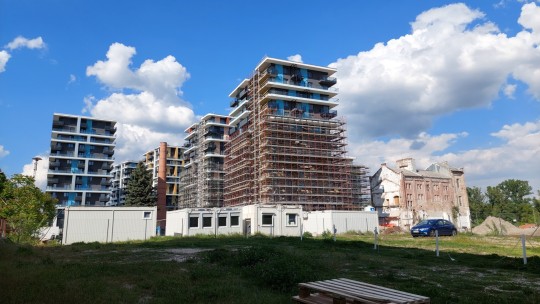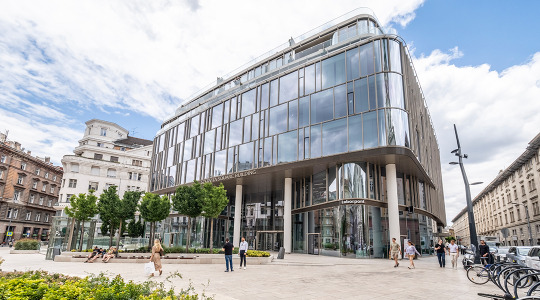#Graphisoft
Text
Graphisoft Revolutionizes Architecture with AI Visualizer for Creative Design Exploration
Graphisoft, a leading Building Information Modeling (BIM) software developer, has integrated an AI-powered visualizer, Archicad AI Visualizer, into its flagship software.
This AI tool, powered by Stable Diffusion, enables architects to generate detailed 3D visualizations in the early design stages, fostering creativity and productivity. The tool seamlessly integrates with Archicad, allowing…

View On WordPress
0 notes
Text
The future architecture of Graphisoft

Graphisoft has customarily done this once a year, at the launch event of the most recent release, in order to inform the public about new features created for Archicad.
The focus of Archicad development is typically a surprise, save from for beta testers. This year, we experienced something entirely new. Not only was there a brand-new release, but there were also four focus-area roadmaps covering the years 2022 through 2025.
Huw Roberts, Graphisoft's CEO, is likely largely responsible for the move because he has been gradually changing the company's marketing and communication strategies. Additionally, Archicad is undergoing significant software architecture changes to better prepare it for tomorrow's hybrid computing requirements, as well as broader, more multi-disciplinary vertical developments. Revit, Archicad's biggest competitor, is also the subject of industry concern regarding its development futures. This marks the beginning of a transformation.
Multilane Roadmap
If an Archicad roadmap has ever been seen previously, it was probably only for one particular product. Multiple roadmaps are necessary since core Archicad will now serve as the home for numerous verticals and the offers will be enhanced through new products and services.
Were given a tour of the various roadmaps by Zsolt Kerecsen, vice president of product development, and Shesh Gorur, vice president of product success.
The key areas focus is:
Architecture: which covers design, document, visualise and collaborate.
Multi-Disciplinary Design: featuring OpenBIM, integrated design and DDScad (Graphisoft’s MEP solution).
Design Team Collaboration: including BIMcloud, BIMx, OpenBIM & BCF, and CDE connections.
Productive Ecosystem: which is the support services – Graphisoft Forward, Graphisoft Learn and Graphisoft Community.
We received a roadmap from Graphisoft for each area of focus. The business will concentrate on offering BIM workflows that are well-connected, beginning with Architecture in 2022. In doing so, problems with OpenBIM and simple information exchange will be addressed.
In 2023, integrated BIM data systems, growing shared models, integrated design, and data reservation will be the major topics in architecture. The goal of integrated user experience development in 2024 will be to standardise interfaces, provide shared capabilities, and provide streamlined training. The company will address integrated enterprise management in 2025 and will focus on shared resources, multitiered management, and orchestrated administration.
Dynamic design editing tools, a design options and variants system, an attribute management system, reflected ceiling plans, design stage level of detail, and an analytic integration system are some of the planned capabilities highlights for architecture.
The year 2022 will bring us simpler information interchange, BIMcloud connectivity, and the DDScad viewer for the building systems category. Integrated data and processes that support common data models, integrated workflows, and a wider geographic reach will be the focus in 2023. Integration of user experiences, interface consistency, shared capabilities, and training simplification are all addressed by 2024. Integrated enterprise management will be realised by 2025, supporting a multi-tier management system, orchestrated administration, and a worldwide reach.
Adaptive Frameworks
Graphisoft predicts a different future than certain companies, who believe that the cloud will become the central location for everything. It anticipates that users will switch between different devices during the day. It also holds the opinion that working on a desktop, on the cloud, or even combining both can be more advantageous at times. The technological stack of Archicad is now being redesigned by Graphisoft to better position it for this hybrid method of working.
The microkernel, referred to as the foundation layer by Graphisoft, performs fundamental functions like login, loading, licence management, and security. The generic BIM authoring layer sits on top of this, into which any vertical discipline application will be plugged. Among the verticals that Graphisoft envisions are architectural, mechanical, plumbing, structural, and electrical.
Additionally, Archicad will specify internal services, external services, and plug-ins that the basic BIM authoring layer and the vertical discipline layers can use.
Users can choose whether to conduct some processing locally or through cloud services. Archicad will be highly "integratable," allowing it to use desktop plug-ins, online services, add-on libraries, and customizations. The ability to process either online or offline will be a first for the sector and seeks to provide the most adaptable architecture for all user requirements.
As a result of this work, Graphisoft will have several entry points to add in new capabilities when disruptive technologies, such as augmented reality, artificial intelligence (AI), blockchain, algorithmic design, generative design, and robotic process automation, emerge. These entry points can be through APIs, desktop or cloud services, third parties, or in-house resources.
Conclusion
Graphisoft has made a number of new personnel, including Ron Close, VP of marketing (ex Solidworks and Shapr3D). As a result, Graphisoft now has some experience in the business from corporate markets that are more competitive. These appointments, based on conversations at the occasion, seem to have given my approach to the competition more concentration and purpose.
This, together with the fresh opportunities that DDScad would open up for the multidisciplinary market, gave the impression of a new, more confident Graphisoft.
Perhaps it was expected that Graphisoft would come up with a different response to the challenges of future. The truth is that despite the opinion of some computer scientists working for software businesses that all software and services should be moved to the cloud, customers aren't rushing to do so.
In order to maintain its composure, Graphisoft deliberately designed their product to be as adaptable and expandable as possible. We eagerly await a demonstration of this when it is put into practise, choosing between local and cloud processing of the same data.
0 notes
Text
Ma Óbudán sétáltam egy nagyot a párommal.

Épül a bigdzsordzsiz lakótelepe a Waterfront City. A már átadott épületekben úgy minden huszadik lakásban van fent függöny. A párom szerint egy csomó kínai vásárol az ilyenekben lakást, aztán nem költöznek be. Amúgy @annacsii nem csak a kémény maradt meg, hanem van még valami régi épület is - itt jobbra:

Aztán tovább északra.

Van ilyen legál graffiti fal a Harisnyagyárnál.

Az év járdája díjas helyszín: 5 méter járda, amin eljuthatsz a lezáró korlátig.

A Gázgyár felé a platánsor most is gyönyörű volt. Nagyon szeretem ezt a sétányt, jó lenne ide az aszfaltút helyett valami promönád.

Ezek a házak valamikor a gázgyári tisztviselőknek épültek. 3-4 lakás van egy-egy ilyen villaépületben. Még ma is egész jól őrzik az összképet, egy kis garázs bontással és kerítésfestéssel egészen szép állapotokat lehetne előidézni.

A gázgyári épületekből csak ezt újították fel sajnos. Ezzel is kellene valamit kezdeni, kezdve egy régészeti feltárással és egy talajcserével. Eszméletlen életet lehetne ide hozni, a Graphisoft Park és a Római-part közé.

Nagyon szépek voltak ma a felhők.

A Graphisoft Parktól a főút felé esik a gázgyári dolgozóknak emelt lakótelep, erős Wekerle vibe-okkal.

39 notes
·
View notes
Text

ARCHICAD is a leading Building Information Modeling (BIM) software developed by GRAPHISOFT. It is widely used by architects, designers, engineers, and construction professionals for creating detailed architectural designs, documenting building projects, and facilitating collaboration throughout the design and construction process.
Registration Link: https://www.thesiswritingsupport.com/bim-archicad-workshop/
2 notes
·
View notes
Text
Nem igaz, hogy nincsenek innovatív magyar vállalkozások, csak megpróbálnak radar alatt maradni, elkerülni, hogy a NER felfigyeljen rájuk. Aki teheti, külföldre viszi a cégét vagy azt a részét, ami mozdítható, például az üzleti központját – mutat rá egy kortünetre Bojár Gábor üzletember, az innovatív hazai vállalkozások őstörténetét író Graphisoft alapítója a Della friss adásában.
2 notes
·
View notes
Text
Régen rendszeresen jártam ezen a környéken, ez ugye a Graphisoft park hátsó fertálya. Ami nem a fenszi új corporate épületekből áll, hanem a fokozatosan bontott gyártelepből. A Google Maps szerint az út másik oldalán a töltés alatti holttérben meg valami közösségi kutyás tér létesült, az is új találmánynak tűnik.
Ha már itt tartunk, szerintem a Sujtás utca is remek legálfal lenne.
4 notes
·
View notes
Text
Szervita Square: A Reflection of the Past Meeting the Future
By Chad Losanta
DVM Group builds a glass building as a sensible reaction to its surroundings.

Built amidst Art Deco and Baroque structures, Szervita Square stands as a lone glass structure
that reflects the city’s cultural past to its modern-day present. Located in Budapest, Hungary, the
edifice stands out as a “sensible reaction” to its surroundings, merging characteristics of
industrial architecture with art deco details. The building functions as a public space as well as a
commercial establishment, bringing people and cultures together to one functional yet
sustainable infrastructure.

Built by the DVM Group, the concept for this infrastructure was to be a soft, wavy glass
sculpture instead of just being a concrete building so it could reflect its neighboring historical
buildings. “We think that the light is the soul of the building so we designed a shell, which lets
the light into the spaces and brings light to its surroundings.” In addition to the reflective exterior
and inner atrium, they managed to create a safe, bright inner courtyard which provides extra
light to middle zones.

Technological innovations made it easy for the DVM Group to design the façade of the structure.
Having to build on such a small space, using prefabricated elements made it possible to finish
the outer shell in just four months. Modern technology made it possible to parallelly build the
outer shell with the interior installations.

Designed using BIM software from Graphisoft like Archicad and BIMx, the planning and
construction of the Szervita Square was made easy. The softwares used created manageable
platforms to create 3D models for easy visualization for developers. Contributing to its
sustainability, BIM models helped the DVM Group prevent unexpected issues occurring onsite.
In a Fire Dynamic Simulation, the DVM Group was able to convince its strict fire authorities of
the safety and integrity of its structure, adding to its sustainability. “If we can avoid such a
problem, we can spare time, work, materials and money,” they explained.

Though built with the latest technology to design and construct, the Szervita Square remains a
reflection of its city’s rich history by reflecting the city’s tangible heritage. These sustainable yet
user-friendly smart buildings were made possible because of the easy collaboration of different
professionals through innovative software provided by Graphisoft.
To learn more about the Szervita Square, The DVM Group, or Graphisoft, be sure to visit their
websites.
Photos by: Ed Simon
Published: 6 September, 2022 (BluPrint)
11 notes
·
View notes
Text
Graphisoft strengthens market presence in Singapore with ACAD Pte Ltd partnership
SINGAPORE – Media OutReach Newswire – 12 August 2024 – Graphisoft, the leading Building Information Modeling (BIM) software solution developer for architecture and multidisciplinary design, has partnered with ACAD Pte Ltd. This strategic collaboration marks a significant milestone for Graphisoft as it aims to expand its reach and enhance service delivery across Singapore. ACAD Pte Ltd will be the…

View On WordPress
0 notes
Text
Top 5 Architectural Drafting Software for Modern Architects

In the fast-evolving world of architecture, having the right tools can make all the difference. Architectural drafting software has revolutionized the way architects design, plan, and visualize their projects. With the advent of digital drafting tools, modern architects can now create detailed and accurate designs more efficiently than ever before. In this blog post, we'll explore the top five architectural drafting software that every modern architect should consider.
1. AutoCAD
Overview: AutoCAD, developed by Autodesk, is one of the most widely used drafting software in the architecture industry. Known for its precision and versatility, AutoCAD offers a comprehensive set of tools for 2D and 3D design, drafting, and modeling.
Key Features:
Extensive Toolset: AutoCAD provides a vast array of tools for creating detailed drawings, including lines, arcs, circles, and more. It also supports complex geometric shapes and 3D modeling.
Customizability: Users can customize the interface, create custom tool palettes, and automate repetitive tasks using scripts and macros.
Collaboration: AutoCAD supports cloud-based collaboration, allowing team members to work on the same project simultaneously and share updates in real-time.
Compatibility: The software is compatible with a wide range of file formats, making it easy to import and export designs.
Why Architects Love It: AutoCAD's precision and comprehensive toolset make it ideal for creating detailed architectural drawings. Its widespread use in the industry also means that architects can easily collaborate with other professionals using the same software.
2. Revit
Overview: Also developed by Autodesk, Revit is a Building Information Modeling (BIM) software that goes beyond traditional drafting by integrating design and construction information into a single, coherent model.
Key Features:
BIM Integration: Revit allows architects to create a digital representation of a building's physical and functional characteristics, which helps in visualizing and analyzing the project.
Parametric Components: The software uses parametric components, meaning that any changes made to a model automatically update related elements, ensuring consistency.
Collaboration and Coordination: Revit supports multi-disciplinary collaboration, making it easier for architects, engineers, and contractors to work together.
Sustainability Analysis: The software includes tools for energy analysis and sustainability assessment, helping architects design environmentally friendly buildings.
Why Architects Love It: Revit's BIM capabilities allow for a more integrated approach to building design, reducing errors and improving efficiency. Its ability to visualize every aspect of a project makes it a powerful tool for architects who want to create sustainable and well-coordinated designs.
3. SketchUp
Overview: SketchUp is a user-friendly 3D modeling software known for its simplicity and versatility. It is particularly popular among architects for creating conceptual designs and visualizations.
Key Features:
Ease of Use: SketchUp's intuitive interface and simple tools make it accessible to beginners, while its powerful modeling capabilities cater to professionals.
3D Warehouse: The software provides access to an extensive library of pre-made 3D models, including furniture, buildings, and landscaping elements.
Plugins and Extensions: SketchUp supports a wide range of plugins and extensions that enhance its functionality, such as rendering, animation, and analysis tools.
Cloud Collaboration: SketchUp offers cloud-based collaboration, allowing teams to share and review designs easily.
Why Architects Love It: SketchUp's ease of use and flexibility make it an excellent tool for quickly creating and iterating on design concepts. Its extensive library of models and plugins also adds to its versatility.
4. ArchiCAD
Overview: ArchiCAD, developed by Graphisoft, is another leading BIM software widely used in the architecture industry. It offers a comprehensive set of tools for designing buildings and managing building information.
Key Features:
Integrated Design Environment: ArchiCAD integrates all aspects of building design, from 2D drafting to 3D modeling and documentation, in a single platform.
Collaborative Workflow: The software supports a collaborative workflow, allowing multiple users to work on the same project simultaneously.
Visualization Tools: ArchiCAD includes advanced visualization tools, such as photorealistic rendering and virtual reality, to help architects present their designs.
Interoperability: The software supports various file formats, making it easy to share data with other software and stakeholders.
Why Architects Love It: ArchiCAD's robust BIM capabilities and collaborative features make it a top choice for complex building projects. Its visualization tools also help architects effectively communicate their ideas to clients and stakeholders.
5. Vectorworks Architect
Overview: Vectorworks Architect is a versatile design software that combines BIM and CAD capabilities. It is known for its robust modeling tools and flexibility in handling different types of projects.
Key Features:
Flexible Design Process: Vectorworks Architect allows architects to design in 2D and 3D simultaneously, providing flexibility in the design process.
Comprehensive Toolset: The software includes tools for drafting, modeling, rendering, and documentation, making it a one-stop solution for architectural design.
Data Integration: Vectorworks Architect supports the integration of data from various sources, including GIS and IFC, for better project coordination.
Visualization and Presentation: The software offers advanced rendering and presentation tools, enabling architects to create high-quality visualizations.
Why Architects Love It: Vectorworks Architect's flexibility and comprehensive toolset make it suitable for a wide range of architectural projects. Its ability to integrate data from different sources also enhances project coordination and accuracy.
Conclusion
Choosing the right architectural drafting software is crucial for modern architects. The software tools mentioned above AutoCAD, Revit, SketchUp, ArchiCAD, and Vectorworks Architect—offer a range of features and capabilities that cater to different aspects of architectural design. Whether you are looking for precise drafting, comprehensive BIM integration, or flexible 3D modeling, there is a software option that can meet your needs. As technology continues to evolve, these tools will undoubtedly play an increasingly important role in shaping the future of architecture.
#Architectural Drafting Services#Architectural Drafting#Drafting Software#Drafting Tool#digital drafting tools#architects#modern architect
0 notes
Text
Top 10 BIM Software List for Architects and Engineers in 2024

Building Information Modeling (BIM) has become an integral part of the architecture, engineering, and construction (AEC) industries. It offers a digital representation of the physical and functional characteristics of a facility, enabling better collaboration, visualization, and decision-making. In 2024, the BIM software market continues to evolve, providing more advanced tools and features. Here's the top 10 BIM software list that architects and engineers can leverage this year.
1. Graphisoft ArchiCAD
ArchiCAD by Graphisoft is another popular BIM software, particularly favored for its user-friendly interface and powerful modeling capabilities. It allows architects to design, visualize, and document building projects efficiently. ArchiCAD's open BIM approach supports various file formats, enhancing interoperability.
2. Trimble SketchUp
SketchUp is widely used for its simplicity and intuitive interface. It’s an excellent choice for conceptual design and early-stage modeling. While it may not have the advanced BIM capabilities of other tools, its integration with Trimble Connect and various plugins makes it a versatile option for architects and engineers.
3. Allplan Architecture
Allplan Architecture is a robust BIM solution that offers advanced modeling, visualization, and collaboration features. It supports the entire design and construction process, from initial concept to final documentation. Allplan's strong interoperability and integration with other Nemetschek Group products make it a solid choice for multidisciplinary teams.
4. Autodesk Civil 3D
Civil 3D is tailored for civil engineering design and documentation. It offers tools for creating detailed civil designs, including roadways, site grading, and utilities. The software's integration with AutoCAD and other Autodesk products ensures a smooth workflow and data exchange.
5. Dassault Systèmes CATIA
CATIA by Dassault Systèmes is a powerful tool for complex and large-scale projects. It's widely used in the aerospace and automotive industries but also offers strong capabilities for architectural and construction projects. CATIA's advanced surface modeling and integration with other Dassault products make it a versatile BIM solution.
6. BricsCAD BIM
BricsCAD BIM offers a unique combination of familiar 2D drafting and advanced 3D modeling capabilities. It’s known for its flexible licensing and affordability. BricsCAD BIM supports a wide range of file formats and integrates with Bricsys 24/7 for cloud-based collaboration.
7. Rhinoceros (Rhino) with VisualARQ
Rhinoceros, or Rhino, is known for its powerful NURBS modeling capabilities. When combined with the VisualARQ plugin, Rhino becomes a robust BIM solution for architectural design. This combination is particularly popular for freeform and complex geometries.
8. BIMx by Graphisoft
BIMx is a mobile and desktop application that allows for the visualization of ArchiCAD projects. It offers an interactive 3D environment for exploring models and documentation. BIMx is particularly useful for presenting designs to clients and stakeholders.
9. AECOsim Building Designer
AECOsim Building Designer by Bentley Systems provides a comprehensive set of tools for building design, analysis, and documentation. It's particularly strong in infrastructure projects and supports various file formats for seamless data exchange.
10. MagiCAD
MagiCAD is specialized BIM software for MEP design. It offers tools for HVAC, electrical, and plumbing systems, with extensive libraries of manufacturer-specific components. MagiCAD is known for its accurate calculations and detailed design capabilities.
Conclusion
Choosing the right BIM software depends on your specific needs and project requirements. Whether you're an architect, engineer, or construction manager, there's a BIM solution that can enhance your workflow and improve project outcomes. The above list represents some of the best options available in 2024, each offering unique features and benefits. As the AEC industry continues to evolve, staying updated with the latest BIM technologies is crucial for success.
0 notes
Text
Architecture Design Software Market to See Major Growth by 2030

Global Architecture Design Software Market Report from AMA Research highlights deep analysis on market characteristics, sizing, estimates and growth by segmentation, regional breakdowns & country along with competitive landscape, player’s market shares, and strategies that are key in the market. The exploration provides a 360° view and insights, highlighting major outcomes of the industry. These insights help the business decision-makers to formulate better business plans and make informed decisions to improved profitability. In addition, the study helps venture or private players in understanding the companies in more detail to make better informed decisions.
Major Players in This Report Include,
Autodesk Inc. (United States), Siemens Industry Software Inc (United States), Dassault Systemes (France), Robert McNeel & Associates (United States), Chief Architect, Inc (United States), Trimble Inc (United States), Chaos Software (Bulgaria), GRAPHISOFT SE (Hungary), BENTLEY SYSTEMS, INCORPORATED (United States), Act-3D (The Netherlands), Asynth (France), Vectorworks, Inc (United States).
Free Sample Report + All Related Graphs & Charts @: https://www.advancemarketanalytics.com/sample-report/106655-global-architecture-design-software-market
The global architecture design software market is expected to grow at a significant pace during the forecast period, according to the AMA study. The rising demand for effective construction modeling propelled by the growing number of construction projects in residential & commercial sectors is one of the major factors aiding into the growth of the market.
Market Drivers
Increasing Demand for Effective Construction Modelling Propelled by Growing Number of Construction Projects in Residential & Commercial Sectors
Increasing Demand for Attractive Interior Designing in Residential & Commercial Sectors
Market Trend
Implementation of Artificial Intelligence in Architectural Design Software
Opportunities
Growing Construction Projects Across Different Regions will Boost the Demand for Architecture Design Software During the Near Future
Challenges
High Cost of Software
Enquire for customization in Report @: https://www.advancemarketanalytics.com/enquiry-before-buy/106655-global-architecture-design-software-market
In this research study, the prime factors that are impelling the growth of the Global Architecture Design Software market report have been studied thoroughly in a bid to estimate the overall value and the size of this market by the end of the forecast period. The impact of the driving forces, limitations, challenges, and opportunities has been examined extensively. The key trends that manage the interest of the customers have also been interpreted accurately for the benefit of the readers.
The Architecture Design Software market study is being classified by Application (Buildings and Facilities, Electric and Gas Utilities, Government, Mapping and Surveying, Mining, Rail and Transit, Roads and Highways), Enterprise Size (Small & Medium Enterprises, Large Enterprises), Platform (IOS, Windows, Android), Deployment (On-Premise, Cloud-Based), Operation (Design, Coordination, Visualization, Collaboration, Productivity Enhancement)
The report concludes with in-depth details on the business operations and financial structure of leading vendors in the Global Architecture Design Software market report, Overview of Key trends in the past and present are in reports that are reported to be beneficial for companies looking for venture businesses in this market. Information about the various marketing channels and well-known distributors in this market was also provided here. This study serves as a rich guide for established players and new players in this market.
Get Reasonable Discount on This Premium Report @ https://www.advancemarketanalytics.com/request-discount/106655-global-architecture-design-software-market
Extracts from Table of Contents
Architecture Design Software Market Research Report
Chapter 1 Architecture Design Software Market Overview
Chapter 2 Global Economic Impact on Industry
Chapter 3 Global Market Competition by Manufacturers
Chapter 4 Global Revenue (Value, Volume*) by Region
Chapter 5 Global Supplies (Production), Consumption, Export, Import by Regions
Chapter 6 Global Revenue (Value, Volume*), Price* Trend by Type
Chapter 7 Global Market Analysis by Application
………………….continued
This report also analyzes the regulatory framework of the Global Markets Architecture Design Software Market Report to inform stakeholders about the various norms, regulations, this can have an impact. It also collects in-depth information from the detailed primary and secondary research techniques analyzed using the most efficient analysis tools. Based on the statistics gained from this systematic study, market research provides estimates for market participants and readers.
Contact US :
Craig Francis (PR & Marketing Manager)
AMA Research & Media LLP
Unit No. 429, Parsonage Road Edison, NJ
New Jersey USA – 08837
Phone: +1 201 565 3262, +44 161 818 8166
[email protected]
#Global Architecture Design Software Market#Architecture Design Software Market Demand#Architecture Design Software Market Trends#Architecture Design Software Market Analysis#Architecture Design Software Market Growth#Architecture Design Software Market Share#Architecture Design Software Market Forecast#Architecture Design Software Market Challenges
0 notes
Text
Revolutionizing AEC Collaboration: The Role of Archicad in AEC Viewer
In the fast-paced world of Architecture, Engineering, and Construction (AEC), effective collaboration and seamless communication are paramount for successful project outcomes. With the advent of technology, the traditional methods of sharing and reviewing architectural designs have undergone a significant transformation. One such groundbreaking tool that has revolutionized the way professionals in the AEC industry collaborate is Archicad in the AEC Viewer.
Archicad, developed by Graphisoft, has long been recognized as a leading Building Information Modeling (BIM) software. Its intuitive interface and powerful features have made it a favorite among architects and designers worldwide. However, its integration into AEC Viewer platforms has taken its capabilities to a whole new level.
AEC Viewer platforms, built to facilitate collaboration and communication among project stakeholders, allow users to view, annotate, and review architectural models in real time, regardless of their location. By incorporating Archicad into these platforms, architects, engineers, contractors, and clients can now access and interact with BIM models seamlessly, fostering a more efficient and productive workflow.
One of the key benefits of using Archicad in AEC Viewer is its ability to maintain the integrity of BIM data throughout the collaboration process. As changes are made to the architectural model in Archicad, they are automatically synchronized with the AEC Viewer, ensuring that all stakeholders have access to the most up-to-date information. This real-time synchronization minimizes errors, reduces rework, and enhances overall project efficiency.
Moreover, Archicad's advanced visualization capabilities enhance the viewing experience within AEC Viewer platforms. Users can explore architectural designs in 3D, analyze building components, and even simulate construction sequences, providing valuable insights that aid in decision-making and problem-solving.
Another advantage of utilizing Archicad in AEC Viewer is the seamless integration with other software and tools commonly used in the AEC industry. Whether it's importing data from structural analysis software, coordinating with MEP (Mechanical, Electrical, and Plumbing) systems, or exporting models for 3D printing, Archicad ensures compatibility and interoperability, facilitating smooth collaboration among multidisciplinary teams.
Furthermore, Archicad's commitment to innovation and sustainability aligns perfectly with the evolving needs of the AEC industry. With features like energy analysis, green building certification support, and enhanced documentation tools, Archicad empowers architects and designers to create environmentally conscious and sustainable designs.
Explore the extensive Archicad services offered by nCircle Tech, designed to simplify your architectural projects. Our skilled staff uses Archicad's sophisticated features to provide creative solutions for your design demands, from BIM modeling to visualization. With our specialized Archicad services, you can improve your architectural workflow.
In conclusion, the integration of Archicad into AEC Viewer platforms represents a significant advancement in the way professionals in the AEC industry collaborate and communicate. By leveraging the power of BIM technology and real-time collaboration tools, stakeholders can streamline workflows, improve decision-making, and ultimately deliver better-built environments for communities around the world. As the AEC industry continues to evolve, Archicad remains at the forefront, driving innovation and transforming the way we design and build the world around us.
0 notes
Text
Roche and LCNM Address Rising Lung Cancer in Non-Smoking Women
Roche Malaysia and Lung Cancer Network Malaysia hosted an event titled ‘A Breath Of Fresh Hope’ to address the rising rates of lung cancer in non-smoking Malaysian women.
The panel discussion highlighted the lack of awareness about factors beyond smoking that contribute to lung cancer in women, such as secondhand smoke, air pollution, asbestos, and radon exposure.
Read More News
Graphisoft…

View On WordPress
0 notes
Link
Graphisoft Archi is a powerful and comprehensive architectural software that allows architects and designers to create, visualize, and analyze their designs in a 3D environment. With its advanced BIM (Building Information Modeling) technology, Graphisoft Archicad streamlines the design and construction process, improves collaboration between project stakeholders and helps to reduce errors and omissions.
0 notes
Video
youtube
GRAPHISOFT X Live 10 - Fachvortrag Aufbau von Großprojekten in Archicad
0 notes
Text
È tornato Satoshi Nakamoto, l'inventore del bitcoin?

Bitcoin, Satoshi Nakamoto è tornato? L'account X @satoshi ha fatto un tweet dopo 5 anni, creando sorpresa e scompiglio.
Satoshi Nakamoto, il misterioso inventore della criptovaluta bitcoin, è tornato. O almeno così pare. Nel pomeriggio di lunedì, infatti, l'account verificato @satoshi ha pubblicato su X un tweet che recita: “Bitcoin è una macchina predicativa. Nei prossimi mesi esploreremo diversi aspetti che non erano esplicitamente contenuti nel white paper. Questi aspetti sono tutti parte di bitcoin e sono importanti. Alcune di queste idee sono state accennate nei primi anni; ora è il momento di estrapolarle e spiegarle”.
Bitcoin is a predicate machine. Over the following months, we shall explore different aspects that were not explicitly contained within the white paper. These aspects are all parts of bitcoin, and are important. Some of these ideas were touched upon in the early years; now is…
— Satoshi Nakamoto (@satoshi) October 2, 2023
Un ritorno sui social del tutto inaspettato, considerando che l'account non pubblicava dal 2018 e che non si hanno notizie certe di Nakamoto da ben 15 anni. Proprio per questo, il tweet ha riscosso subito un successo incredibile, guadagnando quasi 20.000 Like e oltre 5000 retweet.
Nonostante questo, è inevitabile che l'autenticità del contenuto sia stata messa in discussione dai seguaci più fedeli di Nakamoto, che faticano a credere che sia tornato in rete in modo così inaspettato, considerando che mantiene il suo anonimato da quasi due decenni.

BUDAPEST, HUNGARY - SEPTEMBER 22: A statue of Satoshi Nakamoto, a presumed pseudonym used by the inventor of Bitcoin, is displayed in Graphisoft Park on September 22, 2021 in Budapest, Hungary. The statue's creators, Reka Gergely and Tamas Gilly, used anonymized facial features, as Nakamoto's true identify remains unconfirmed. (Photo by Janos Kummer/Getty Images)Janos Kummer/Getty Images
Non è un caso, infatti, che molti abbiano attribuito il tweet a Craig Wright, un informatico australiano che da anni sostiene di essere l'inventore del bitcoin, senza mai essere riuscito a mostrare prove evidenti a sostegno di questa teoria.
Eppure, a dicembre 2022 un utente di Twitter di nome Andy Rowe ha ammesso chiaramente di aver preso parte sia alla gestione dell'account @satoshi sia all'attività di Wright, dimostrando così un legame tra l'australiano e l'inventore della criptovaluta.
Una vicinanza che, in questi giorni, ha confermato anche Christen Ager-Hanssen, l'ex CEO della società di blockchain nChain, dichiarando che l'account @satoshi “è stato rilevato da Craig”, dopo essere stato di proprietà dello stesso Rowe. Allo stato attuale, quindi, sembrerebbe che l'account X sia davvero in mano a Wright, a cui spetterebbe la paternità del tweet.
Isn’t it a coincident that @satoshi account is used during this time when I expose Craig?
That account has been taken over by Craig. The previous owner is a Craig Wright fanboy @andyrowe
Don’t be fooled guys! pic.twitter.com/4qtn8Dhx2P
— Christen Ager-Hanssen (@agerhanssen) October 2, 2023
I dubbi quindi sono forti, considerando, infine, che l'account da cui è stato condiviso il tweet risulta come verificato, il che significa che il suo proprietario ha volutamente scelto di collegarvi la propria carta di credito. Un comportamento da cui Nakamoto in persona si sarebbe tenuto ben alla lontana, considerata la sua ossessione per la privacy e l'anonimato.
Read the full article
0 notes